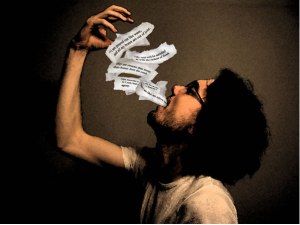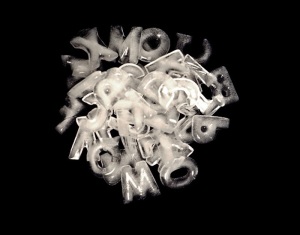 Reading poetry is not always easy. It’s a kind of writing that most of us aren’t used to seeing very often. There are many different types of poems, structures, rhyme schemes, free verse, prose poetry, all with different forms, all of which require a different way of reading. Words dance around on the page. Line breaks come in odd and sometimes awkward places. How is one meant to read these pieces? Where does one thought end and the next begin? Do you treat each line as its own sentence and pause at the end? When do you stop for a breath? These are just some of the common questions that can confront and confound readers of poetry.
Reading poetry is not always easy. It’s a kind of writing that most of us aren’t used to seeing very often. There are many different types of poems, structures, rhyme schemes, free verse, prose poetry, all with different forms, all of which require a different way of reading. Words dance around on the page. Line breaks come in odd and sometimes awkward places. How is one meant to read these pieces? Where does one thought end and the next begin? Do you treat each line as its own sentence and pause at the end? When do you stop for a breath? These are just some of the common questions that can confront and confound readers of poetry.
Of course some poetry is far easier to read and understand, but many poets seem to almost delight in making their poems as tricky and strange as possible, leading to the popular belief that poetry is “difficult” reading. Well, I’m not here to deny that some poets and poetry can indeed be difficult to read and understand (I’ve struggled with more than a few myself). But I will offer this one small tip, which can make reading poetry a far easier experience while still offering a challenge to readers, albeit an engaging one and one that offers a simple key to unlocking a poem’s beauty.
For a long time I too subscribed to the belief that poetry was difficult and  abstruse. I asked many of the questions posed above and was unable to make heads or tails of many poets and poems. I was stuck in a rigid reading mentality, used to reading straightforward narrative prose, when reading poetry requires a far more fluid and flexible manner of reading. It wasn’t until taking a poetry class in college that I was finally able to break out of my usual way of reading. When I read the poems at home, I encountered the same difficulties as I always had with poetry. But in class, listening to the teacher read them aloud they took on a whole new shape and meaning. They suddenly made more sense—if not always in terms of content, certainly in their form.
abstruse. I asked many of the questions posed above and was unable to make heads or tails of many poets and poems. I was stuck in a rigid reading mentality, used to reading straightforward narrative prose, when reading poetry requires a far more fluid and flexible manner of reading. It wasn’t until taking a poetry class in college that I was finally able to break out of my usual way of reading. When I read the poems at home, I encountered the same difficulties as I always had with poetry. But in class, listening to the teacher read them aloud they took on a whole new shape and meaning. They suddenly made more sense—if not always in terms of content, certainly in their form.
What was it that made the difference in reading the poems silently at home  and listening to someone read them aloud? The difference was tempo, tone, musicality. The poems were no longer just words printed in tiny black ink on a sheet of paper, but instead were transformed into sound, into rhythm, into cadence, into song. Hearing the poems and reading the poems were two completely different experiences. Listening to poems that had previously seemed impenetrable made them suddenly come alive. It was as if this was how the poems were supposed to be heard. Just as reading a newspaper account of a volcano erupting cannot capture anything of the majesty of the sight, or viewing a blueprint of a cathedral fails to replicate the soaring beauty of the building, simply reading a poem on the page does not allow for its full beauty and nuance to unfold. Since many poems were written to be read aloud by a human voice, it stands to reason that this is how we should experience them. By so doing, we are allowing the poet to utilize the full measure of the medium in order that his or her work might move us.
and listening to someone read them aloud? The difference was tempo, tone, musicality. The poems were no longer just words printed in tiny black ink on a sheet of paper, but instead were transformed into sound, into rhythm, into cadence, into song. Hearing the poems and reading the poems were two completely different experiences. Listening to poems that had previously seemed impenetrable made them suddenly come alive. It was as if this was how the poems were supposed to be heard. Just as reading a newspaper account of a volcano erupting cannot capture anything of the majesty of the sight, or viewing a blueprint of a cathedral fails to replicate the soaring beauty of the building, simply reading a poem on the page does not allow for its full beauty and nuance to unfold. Since many poems were written to be read aloud by a human voice, it stands to reason that this is how we should experience them. By so doing, we are allowing the poet to utilize the full measure of the medium in order that his or her work might move us.
So is cracking a poem as simple as just reading it aloud? Not exactly. As with most things worthwhile, poetry takes a little bit of work. Reading aloud is the first step. After that it is a matter of trial and error, of sounding out the poem, seeing how words and phrases fit together, trying out different rhythms and pauses. This is where the fun (to me, anyway) part comes in. It is very much like fitting together an audible jigsaw puzzle. It is the task of discovering the music in the poem. It sounds a bit odd, I realize, but give it a try sometime. I think you’ll be pleasantly surprised by the difference a human voice can make to a poem, by the push and pull of the words, and by the song emerging from within.
For an example of what I mean by all this, below you’ll find a poem by 20th Century American poet Galway Kinnell called “First Song.” The poem itself is lovely to read on paper. But I’ve also included below a video clip of Illinois-based musician Andrew Bird performing his musical version of Kinnell’s poem (a recording of which can be found on Bird’s very fine album Weather Systems). The addition of Bird’s wonderful whistling and guitar add a whole new layer to the poem, but notice especially Bird’s phrasing of the lines, how he twists and wraps lines together, connects rhymes and images, draws words out and gives them space to breathe. This is, to me, a prime example of unlocking the musicality of a poem. After hearing the poem like this, it’s hard to go back to reading or hearing it in any other way. Read the poem as words. Listen to it as music. See which way offers more understanding, more beauty. And then call a poem up out of your mouth, let the sound resonate and vibrate inside of you, and find your own music.
Century American poet Galway Kinnell called “First Song.” The poem itself is lovely to read on paper. But I’ve also included below a video clip of Illinois-based musician Andrew Bird performing his musical version of Kinnell’s poem (a recording of which can be found on Bird’s very fine album Weather Systems). The addition of Bird’s wonderful whistling and guitar add a whole new layer to the poem, but notice especially Bird’s phrasing of the lines, how he twists and wraps lines together, connects rhymes and images, draws words out and gives them space to breathe. This is, to me, a prime example of unlocking the musicality of a poem. After hearing the poem like this, it’s hard to go back to reading or hearing it in any other way. Read the poem as words. Listen to it as music. See which way offers more understanding, more beauty. And then call a poem up out of your mouth, let the sound resonate and vibrate inside of you, and find your own music.
First Song by Galway Kinnell
Then it was dusk in Illinois, the small boy
After an afternoon of carting dung
Hung on the rail fence, a sapped thing
Weary to crying. Dark was growing tall
And he began to hear the pond frogs all
Calling on his ear with what seemed their joy.
Soon their sound was pleasant for a boy
Listening in the smoky dusk and the nightfall
Of Illinois, and from the fields two small
Boys came bearing cornstalk violins
And they rubbed the cornstalk bows with resins
And the three sat there scraping of their joy.
It was now fine music the frogs and the boys
Did in the towering Illinois twilight make
And into dark in spite of a shoulder’s ache
A boy’s hunched body loved out of a stalk
The first song of his happiness, and the song woke
His heart to the darkness and into the sadness of joy.
“The sound of the words creates a mood far more powerful than the meaning of the words themselves.” –Andrew Bird on “First Song”
